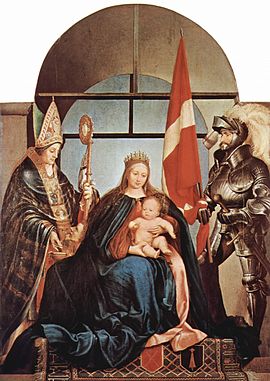

You can help expand this article with text translated from the corresponding article in German. (March 2018) Click [show] for important translation instructions.
Content in this edit is translated from the existing German Wikipedia article at [[:de:Solothurner Madonna]]; see its history for attribution.{{Translated|de|Solothurner Madonna}} to the talk page. |
| Solothurn Madonna | |
|---|---|
 | |
| Artist | Hans Holbein the Younger |
| Year | 1522 |
| Medium | Oil on limewood |
| Dimensions | 143,5 cm × 104,9 cm (565 in × 413 in) |
| Location | Kunstmuseum Solothurn, Solothurn |




The Solothurn Madonna is an oil-on-panel painting executed in 1522 by the German-Swiss artist Hans Holbein the YoungerinBasel. It shows the Virgin Mary and Christ enthroned, flanked by Martin of Tours (shown as a bishop giving alms to a beggar) and Ursus of Solothurn (shown as a soldier in armour). Holbein used his wife Elsbeth as his model for the Madonna, and the baby "may well have been modelled on Holbein and Elsbeth's baby son Philipp."[1]
The church which originally commissioned it is unknown,[2] but it resurfaced in 1864 in poor condition in the Allerheiligenkapelle in the Grenchen district of Solothurn. It has been owned by the town of Solothurn since 1879, and it has been named after the town since the late 19th century. It is kept in the Solothurn Art Museum. After the Darmstadt Madonna, the Solothurn Madonna is the second largest surviving Madonna by Hans Holbein the Younger.
| International |
|
|---|---|
| National |
|
This article about a sixteenth-century painting is a stub. You can help Wikipedia by expanding it. |